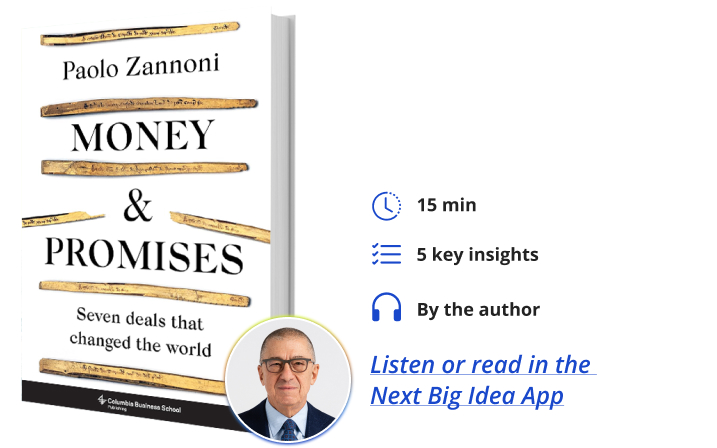Paolo Zannoni is the executive deputy chairman of the Board of Prada, president of Prada Holding, and international advisor to the executive office of Goldman Sachs International. He is also a member of the advisory board of the Jackson Institute and the Center for International Finance at Yale University. He was formerly a partner of Goldman Sachs, chairman of the board of Prysmian, president of Fiat USSR, and president of Fiat USA.
Below, Paolo shares five key insights from his new book, Money and Promises: Seven Deals That Changed the World. Listen to the audio version—read by Paolo himself—in the Next Big Idea App.

1. Modern money is debt.
Modern money is debt, the debt of banks. We say we go to the bank to get money or borrow money from the bank, but we get it all wrong. Whether we are paying with debt or credit cards or electronic transfer, the goods and services we buy are paid with our bank’s debt, its promises to pay. What is true of us as individuals is the role also of nations and states. Today, sovereign currencies everywhere are made mostly of bank debts. This simple fact explains a lot about the role of banks in society and their relationship with government. In matters of money, banks and states are partners. They support each other. That is why when banks get into trouble, governments bail them out.
It all began in Pisa, with the ideas of one man, Fibonacci. Fibonacci spent time trading in the southern Mediterranean, where he learned Arabic and Indian mathematics. In his Liber Abaci, written in 1202, he outlined the advantages of Arabic and Indian mathematics over the Roman system.
Fibonacci’s is the system taught in schools today, the world over, but that is not all. Liber Abaci was not a theoretical enterprise but a book made for merchants and bankers, a guide to making money from money. It should be understood as a textbook for aspiring financiers. Soon schools of Abaci were set up to train apprentices for banks and merchant houses. Banking knowledge and practices spread. The Republic of Pisa benefited from the spread of financial and banking knowledge.
When Pisa lost its colonies with their silver money, the inflow of precious metal slowed, and the mints could not produce the coins needed for trade and manufacturing. But the golden age of Pisa did not end there. Trade and industry still prospered. Bankers issued debt to traders, manufacturers, and state institutions. Bank debts supported the state industry and trade. Pisa prospered because there were two types of money: coins from the mints and debt from the local bank.
2. State banks started in Venice.
Rialto is one of the oldest words in the city of Venice. This unlikely spot was once the financial center of the Western world. In the early 1600’s, Vendramin was a bullion dealer in Rialto. He purchased gold and silver on the world market and sold it to the mint. But if the mint price was lower than the price on the world market, the full bullion into the mint dwindled or stopped, and so did the supply of coin money.
“This unlikely spot was once the financial center of the Western world.”
That is exactly what was happening in 1619. The economy and public finances of the republic suffered, and so did Vendramin’s income. Then, Vendramin approached the Senate with an idea. He was willing to sell silver to the minted full price, but he could be flexible on the means of payment. For half the value, he would want coin, but for the other half, he would accept the debt of a special kind of bank. It was a cunning plan and came at the right time.
The Bancogiro was born as a bank to serve the state. Bancogiro, an institution of the state, was the first public bank to issue bank debt money to public offices. Soon, other nations looked at the Venetian experiment to make their own public banks. England moved first.
3. The tally system gave state banks purchasing power.
A tally is a stick used to record financial information. In England, from the 12th century, for over 600 years, tallies became the most used financial instrument, the backbone of public finance and banking. When citizens loaned money to the king, their royal tally cutter recorded the name of the lender and the sum loaned on each side of the stick. Then he split the stick lengthwise. The exchequer kept one piece, the lender the other. Those two pieces fit together as proof of the loan and the debt. The stick was a valid claim on tax revenues.
This is how the English king borrowed from his subjects for hundreds of years. But by the late 1600s, the system was in crisis. Too many tallies had been cut, and the sticks were not worth much. Enter trader and banker William Patterson. His idea was simple: the exchequer cut tallies and delivered one half to the bank in exchange for bank notes, bank debt, or money. The bank was paid the fee to exchange public debt for bank debt, and the state got instantly available purchasing power. The scheme was so successful that the Bank of England became the most copied public bank in the world.
4. North American colonies turned the purchasing power scheme against England itself.
It was a scarcity of coins that pushed the North American colonies to set up a currency made of debts, something not done on such a large scale before. In 1689, the colony of Massachusetts, having no coins, paid its citizen soldiers fighting the French Canadians with bills of credit they could use to pay taxes. The gimmick worked because the citizens returned the bills to the colony when the taxes became due, and the reciprocal indebtedness was cleared.
The Continental Congress, which governed independent colonies from 1776 to 1789, enlarged the practice by issuing many bills of credit. Each bill was a promise by Congress to pay a Spanish silver dollar. The bills could also be used to pay taxes, but the Continental Congress’s politics did not encourage tax raising and compliance. Too many bills remained in circulation, and purchasing power collapsed.
“The gimmick worked because the citizens returned the bills to the colony when the taxes became due, and the reciprocal indebtedness was cleared.”
Robert Morris, the superintendent of finance of the Continental Congress, had an idea on how to increase the purchasing power of public debt. He set up the Bank of North America, owned by Congress and private shareholders. As soon as the bank opened for business, Morris handed the bank a promissory note for $100,000 of public debt. In exchange for the note, he got back $97,000 worth of bank notes. The banknotes held value because they were debts of the bank and everyone accepted them—even in the confederation of an independent state. In this way, U.S. dollars were born, a national currency made only of debts.
5. Russian banking functions between two economic systems.
In February 1990, I moved to Moscow. I went there to close a deal. The deal was the sale of 50 percent of the USSR’s biggest car company to Fiat. The deal had been agreed upon between Gorbachev and Gianni Agnelli, Fiat’s chairman. All that was required was to close the deal, and the job fell to me. The USSR was disintegrated, and I needed a guy to navigate the maze. I was lucky when I found one in Vladimir Yakovlev, the editor-in-chief of Kommersant, the Russian version of The Economist. Vladimir explained to me that since 1917, Russia had had two economies, not one, each taking its name from a Moscow landmark.
The first was the Red Square economy, which consisted of state-owned enterprises run by communist state institutions housed in the Red Square. The second was the so-called Sukharevka economy, which took its name from a very old open-air market in Moscow. Here, peddlers and bagmen traded anything and everything. Cash was king in the Sukharevka. Here, profit, not communist party rules, motivated the participants.
The respective size and importance of the two economies have varied over the 70 years of the Soviet Union, but one economy has never been able to do without the other. The sale of the car company to Fiat was squarely in the province of the Red Square economy. But with the USSR collapsing, closing the deal was impossible, and I left.
Twenty-two years later, I found myself in Moscow again to head Goldman Sachs in Russia. The Sukharevka economy had grown, and the Red Square had diminished, but they were still working side by side. Understanding the Sukharevka and the Red Square—these fundamental features of the Russian economy—is key to understanding the roles that money and banking played in the nation’s financial history.
To listen to the audio version read by author Paolo Zannoni, download the Next Big Idea App today:












